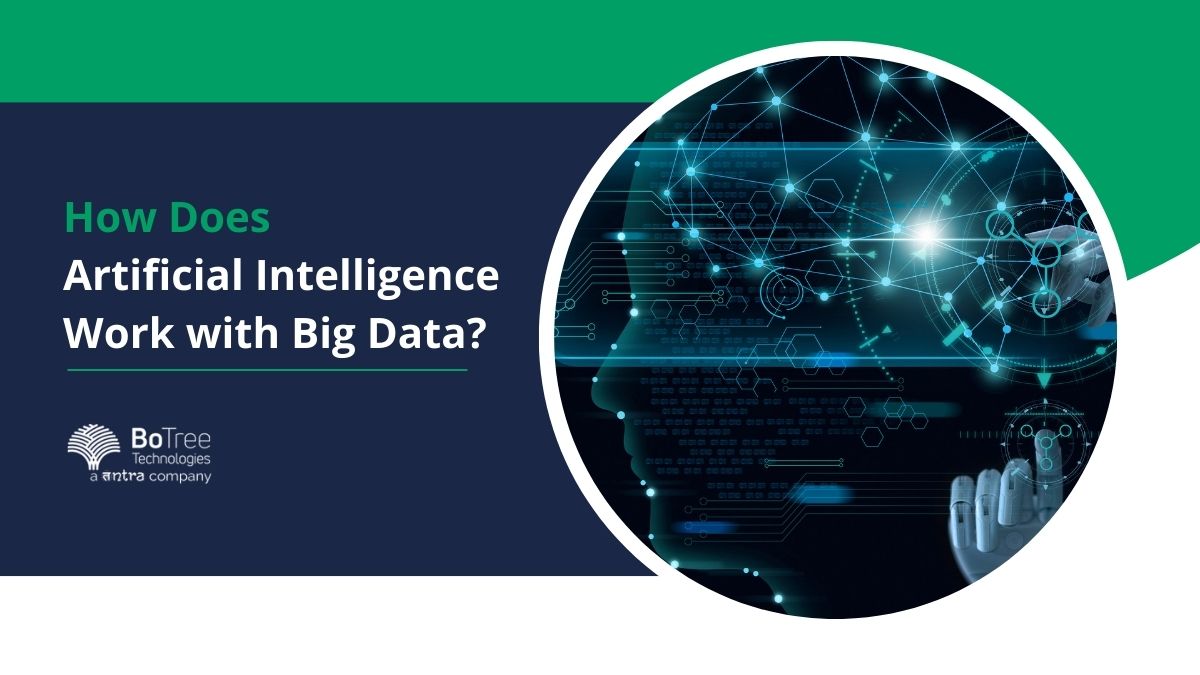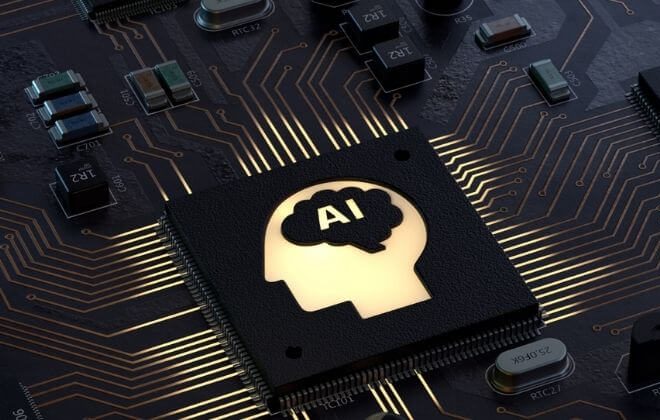
How Does Artificial Intelligence Work with Big Data?
In recent years, businesses have leveraged big data to gain insights for business decision-making. However, managing large amounts of data can be challenging, which is where Artificial Intelligence (AI) comes in. Forward-thinking businesses use technologies like AI-based solutions to improve the efficiency of data analytics. AI applications are crucial as big data analytics tools as they can detect patterns and offer cognitive functionalities for large amounts of data.
By using AI solutions in conjunction with big data, companies can extract more valuable information from their data and gain a competitive advantage in the long term. Read on to find out how the two work together to benefit businesses.
Relation between Artificial Intelligence and Big Data
The first step to understanding how AI services and big data work together to create exceptional intelligence for businesses lies in how the two are related. While big data requires AI for analysis, AI needs big data to learn decision-making processes and patterns and enhance them. It, therefore, becomes easy to take advantage of advanced analytic capabilities and obtain actionable insights and valuable information from your large data volumes.
Besides the synergic relationship, big data and Artificial Intelligence are also linked in the form of research. Big data technology uses AI methods and theories. On the other hand, AI requires large amounts of data and big data-supporting technologies to evolve and improve decision-making capabilities.
The function of AI depends on the amount of data it feeds on, which is where big data comes in. However, the quantity or volume of data is not the only consideration. Other crucial data properties to keep in mind include velocity, veracity, variety, validity, value, and visualization.
Big data can be useless without Artificial Intelligence(AI) as humans can’t effectively analyze it. AI enables machines to carry out tasks similar to using human cognitive powers. The systems can, therefore, make intelligent decisions without needing a human environment.
You can have data with information, but you can’t have information without data, and AI makes it possible to get the best out of big data.
Read more: 10 AI Solutions for Next-Level Customer Experience
How AI Works with Big Data
Businesses collect customer data and derive valuable insights for growth and success. Solutions created by AI experts can add value to users in every phase of the big data process, including those involved in data management like aggregation, storage, and retrieval. With this in mind, it comes in handy in data management, context management, pattern management, decision management, action management, and goal management.
Below are three main ways that AI uses big data.
- Pattern Recognition:
AI can recognize patterns unidentifiable to the human eye. It sifts through data collected by big data analytics to identify patterns over time and homogenous categories. The pattern recognition function of AI is among its most valuable capabilities that allow for optimal functioning of the duo as it plays a role in data filtering. - Detecting and Negating Anomalies:
AI and big data work together to negate data anomalies, which include any unusual properties existing in normal data. As AI studies big data and identifies patterns, it becomes easier to spot different data bits or characteristics, making it possible to negate any data anomalies. While big data helps in data storage, AI makes data cleansing possible to avoid storing data that is irrelevant or useless information. - Creating Algorithms:
When big data providers gather and archive data, AI leverages the information to create algorithms through pattern recognition and anomaly detection. These algorithms enable AI to distinguish data without necessitating additional instructions.
The Benefits of AI on Big Data
Although AI and big data are different, they work perfectly together. AI and big data can improve business intelligence, enhance predictive analysis and lead to better decision-making. Below are the benefits that businesses can enjoy using AI and big data services from a software development company.
1. Better Customer View
- Given the growing digital footprints and data demands, companies can use the data to their advantage and get even more valuable insights. While the cloud and using storage-as-a-service can help you store large amounts of data, managing it can be hectic. With AI, businesses don’t need to move data between data warehouses or spend most of their time creating reports.
- Companies can utilize intelligent, distributed, and automated analytic tools in data lakes to collect and process information from different sources at the same time. Companies can learn more about their customers and use the information to be on top of trends, make better business decisions, and automate processes to improve efficiency.
2. Improved Forecasting
- Previously, businesses would use historical records, such as sales from the previous year, to predict the outcomes of the current year. Unfortunately, relying on traditional forecasting methods can make it difficult to predict future sales and perform price optimization. This may be due to evolving trends, a global pandemic, and unforeseen circumstances.
- AI and big data have the potential to predict future data records by recognizing patterns early and establishing the effects of the trends on future results. The technologies allow businesses to make better decisions by providing more accurate information about potential future events. Companies in retail can use big data and AI technologies to create more accurate seasonal forecasting by reducing errors by up to 50%.
4. Enhanced Customer Acquisition and Retention
- In the current digital world, customers’ digital footprints leave a lot of information about their tastes and preferences, purchasing habits, and needs. AI and big data can help businesses study their customers to understand their needs, behavioral patterns, and even reasons for certain actions, like why they stopped buying a specific product.
- With the information, businesses can develop improvement strategies and tailor their offerings to meet customers’ expectations. The result is better customer service and satisfaction, which attracts more clients and retains the ones they already have. It also aids in creating targeted campaigns that bring value, such as increasing conversions and boosting brand loyalty.
5. Cybersecurity and Fraud Prevention
- Regardless of the size or type of company, every business faces the risk of fraud and cybersecurity threats.AI and big data can help minimize the chances of disasters and fraud by providing more protection against their adverse effects. With AI, businesses can identify patterns and system anomalies and stop suspicious behavior.
- The system can assess large amounts of data to detect, identify and prevent fraudulent activities. They can also combine different data to alert the business about potential cybersecurity risks that haven’t occurred yet, which would otherwise be impossible.
6. Risk Mitigation
- The business environment is inherently risky, which requires businesses to have sound strategies to handle them. To thrive, companies should effectively anticipate, prevent and respond to any adverse changes and risks. AI and big data provide valuable input in risk mitigation through early identification, quantifying exposure to potential losses and risks, and speeding up the necessary action.
- By using big data models, companies can address various risks and challenges brought about by events like natural disasters. The information from the large amounts of data can help to develop better situational awareness, which enables companies to allocate adequate resources to deal with any risks that may jeopardize the business.
7. Fewer Data Problems
- The only way to get the most value is by using high-quality and error-free data. However, data problems occur during acquisition, management, and processing, leading to data that is full of mistakes and, therefore, less integrity.
- No company needs to collect and store large amounts of worthless information. With this in mind, AI and big data can clean up and prepare data by identifying outliers and missing values and differentiating data groups showing similar concepts. This creates consistently high-quality data that provide more accurate insights.
8. Less Labor Input and Lower Costs
- AI and big data reduce employee workload by making data collection and analysis less labor intensive. By reducing the input of humans, companies can let their employees focus on other important things besides data analysis.
- While it may reduce the burden on humans, the duo does not eliminate the need for human input. Similar technologies like the cloud lower the cost of evaluating and storing new data. Lastly, you can utilize AI and big data to identify opportunities to save on cost savings without compromising efficiency.
Conclusion
Combining AI and big data is crucial in today’s fast-paced digital environment. Since the two technologies play a role in data collection and analytics, they can and have produced algorithms that can facilitate better and more effective data analysis.




